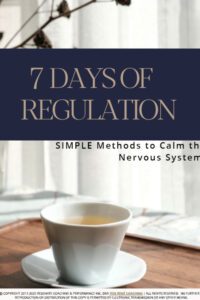Don’t Wait for Joy: How to create joy in hard times…
“Sometimes your joy is the source of your smile, but sometimes your smile is the source of your joy.” — Thich Nhat Hanh
We’re often taught to believe that joy is something we earn, something that comes after everything is resolved, healed, or fixed.
But here’s the truth:
You don’t have to wait for life to “get better” before you feel better.
Table of Contents
Create Joy in Hard Times: Allow Emotions

Allowing emotion isn’t weakness; it’s the beginning of real strength.
“Each time you sit with a feeling instead of spiraling, you strengthen emotional confidence.”
Sadness, joy, irritation, stress about the future, these aren’t moral categories. They’re not signs of failure or evidence that you’re “bad” or “good” at life. They’re simply part of your human experience. Emotions are not meant to be judged; they’re meant to be felt, witnessed, and integrated.
You may have heard this before but it’s worth repeating:
Feelings are not facts. But your body still believes them.
📌 Science Spotlight: Why Feelings Are Not Facts
Your brain reacts before you can think. The amygdala triggers emotional alarms in milliseconds, so your body often feels danger before logic catches up.
Emotions change your physiology. Anxiety speeds your heart, sadness lowers energy — even when the thought isn’t objectively true.
Naming emotions builds regulation. Simply saying “I feel anxious” lowers amygdala activity and lets your rational brain step in.
Practice rewires your nervous system. Each time you sit with a feeling instead of spiraling, you strengthen emotional confidence through neuroplasticity.
Separating Fact From Fiction

Clarity brings calm: the stories we question lose their hold.
Feelings aren’t facts, but your body believes them.
When you notice emotions and name them, you choose your response instead of being ruled by reaction.
That distinction is powerful. A thought like “I’m alone” may not be objectively true, but if loneliness surges in your chest, your nervous system will still brace as though it is.
As a result, the body doesn’t wait for the fact-check, it reacts. Heart racing, shoulders tightening, gut clenching. Dismissing emotions or telling yourself to “just get over it” rarely works. Your body needs to be acknowledged, too.
You get to create joy in hard times and, in doing so, avoid being consumed by what you feel or dread you will feel.
For example, think of it like learning to swim. At first, emotions can feel like waves that knock you under. Over time, you can practise floating, breathing, and finding your footing even when the current is strong.
Psychologists call this affect tolerance or emotional regulation. It’s simply the ability to sit with emotion without spiraling into panic or freezing into numbness. In addition, it’s not a trait you’re either born with or without, it’s a learned skill.
Each time you allow yourself to feel irritation without snapping, or sadness without shutting down, you’re strengthening your “emotional confidence” and the ability to create a feeling you want. You’re teaching your nervous system, I can handle this wave. I don’t have to drown in it.
From a lifestyle perspective:
-
Noticing your body’s cues. The tight jaw, the flutter in your stomach, the heavy eyes.
-
Naming the emotion. Saying quietly, “This is sadness” or “I feel anxious.”
-
Grounding yourself. Taking a breath, placing a hand on your chest, or pausing before reacting.
- Relaxation. Adopt some skills that generally relax your mind and body.
Over time, these micro-practices weave joy into even difficult days, not because the hard feelings disappear, but because you’ve stopped fearing them. You’ve made space for the full spectrum of human experience, and paradoxically, that openness often creates more room for joy.
Create Joy in hard times with Resilience

Resilience is the quiet decision to keep showing up and joy often follows.
“Yes, this hurts. And yes, I can still let in something nourishing.”
Smiling during a hard moment doesn’t mean you’re ignoring the pain. It means you’re letting of the need for things to go well and offering your body something life-giving alongside the hard. .
This is emotional resilience: the ability to let grief and joy exist together. In fact, you don’t have to wait until things “pass” to allow lightness in. Instead, remember that joy isn’t a medal you earn at the end of suffering; it’s something you can invite even in the midst of it.
In addition, it’s a tool for tool for well-being, something you can reach for right now.
Research shows that even small positive moments, for example, pausing for sunlight on your skin, humming to music while cooking, or sharing a laugh, can calm your nervous system and build resilience over time.
In other words, these aren’t acts of denial. They’re acts of kindness. You’re telling your body, “Yes, this hurts. And yes, I can still let in something nourishing.”
Joy doesn’t wait. It begins with what you give yourself today.
Discover what more space feels like
Tired of feeling mentally overloaded and stuck in overthinking?
This free mindset guide will quiet racing thoughts and recharge your energy.
✦ I’m Ready to Find More Ease ✦ →
Create Joy in hard times slowly

.Joy doesn’t rush, it blooms at the pace your body can trust.
“Every time you see a moment of joy in struggle, you’re literally teaching your body a new pattern”
When you smile or allow yourself even a fleeting moment of lightness, you’re doing more than just “cheering up.” In fact, you’re reshaping your internal experience, and over time, you’re training your nervous system toward resilience.
-
You create a positive experience inside a difficult one.
For instance, imagine a rainy day when everything feels scary or heavy. You pause to watch a child splashing in a puddle, or you let yourself hum along to a song in the car. In that moment, joy coexists with fear and hardship. This doesn’t erase the difficulty, but instead, it reminds you that pain or fear isn’t the only thing happening. -
Your body releases calming neurotransmitters.
Smiling, laughing, or even taking a single mindful breath triggers the release of dopamine, serotonin, and endorphins—the body’s natural “feel-better” chemicals. As a result, research shows these microbursts of relief can lower stress hormones like cortisol and support emotional regulation. -
You become more open to connection and support.
When you soften, even slightly, you signal to others that you’re approachable. A gentle smile might invite a kind word from a stranger, or it may remind a friend that you’re willing to receive their care. In hard times, connection can be the very lifeline that steadies you. -
You shift the energy around you—yes, really.
Energy is contagious. Ever walked into a room where someone is laughing and felt yourself lighten without trying? Your choice to smile or breathe deeply doesn’t just change you, it subtly changes how others feel in your presence. In fact, your personal practice becomes a gift to the people around you. -
You remind your nervous system: “I’m safe enough to feel this moment.”
Trauma, stress, or grief often leave the body braced, as if waiting for impact. A small, intentional act of joy tells your nervous system, right now, in this breath, I am safe enough to let in softness. Over time, these reminders rewire your stress response, making calm more accessible.
One small smile… one deep breath… one playful pause can change your state. That’s not shallow or naïve. That’s neuroplasticity at work your brain’s remarkable ability to form new pathways.
Every time you choose joy in the midst of struggle, you’re literally teaching your mind and body a new pattern: Even here, I can find light.
Choose to Smile

Joy often begins with a single smile shared, remembered, or rediscovered.
“Smiling is like adding a pinch of spice to an otherwise plain meal.”
When was the last time you chose to smile on purpose? Not because someone made you laugh or because a stranger waved, but simply because you decided to?
Here’s the surprising thing: research shows that smiling can actually shift your mood, even if it starts out as “pretend.” Psychologists call this the facial feedback hypothesis: the idea that moving your face into the shape of a smile can send signals to your brain.
These signals consequently, boost dopamine and serotonin, your feel-good neurotransmitters. In plain language: your body sometimes gets to lead the way, nudging your mind toward lighter ground.
You create joy in hard times with simple moments:

The smallest celebration is proof of life returning.
Think of the last time you did this. Maybe you were walking down the street, tired or tense, and you softened your face into a small grin. Did you notice how your shoulders eased, or how your next thought wasn’t quite as heavy?
This is why adding micro-moments of joy matters.
Try it now. Pause for just a second, let your lips curve upward, and notice the sensation in your chest or your belly. Even if it feels artificial at first, give it a moment. As a result, the warmth catches up.
Smiling intentionally isn’t about pretending everything’s fine. It’s about remembering that you can invite micro-moments of joy into your day, even in the middle of difficulty. Moreover, it’s like adding a pinch of spice to an otherwise plain meal you’re not denying the meal itself, just giving it a little more flavour:
- Pair your smile with a small, playful ritual.
- Put on a favourite song while you brew your morning coffee.
- Smile at yourself in the mirror before brushing your teeth.
- Send a silly emoji to a friend out of the blue.
In fact, these little gestures weave joy into ordinary routines, helping you anchor in something brighter, even when life feels stormy.
Joy doesn’t always arrive in grand fireworks. More often, it sneaks in through these small, deliberate choices the half-smile, the shared laugh, the quiet moment of remembering that your body and spirit are capable of joy, even here.
Try This Prompt
When was the last time you chose to smile on purpose?
What happened after?
Let yourself remember how that felt.
And then… maybe do it again right now. Even for a second.
Frequently Asked Questions
Q1. How can I feel joy when life feels heavy?
Joy doesn’t mean ignoring pain. Moreover, it begins with small, mindful moments that remind your body it’s still safe to feel lightness. Therefore, when you notice what’s good, even for a second, your nervous system starts to open again.
Q2. What if joy feels fake or forced right now?
That’s okay. Joy can start as a quiet practice, not a feeling. Try gentle sensory moments — warmth on your skin, a kind voice, a deep breath — and let them work slowly. Real joy grows from permission, not pressure.
Q3. How can coaching help me find joy again?
Coaching helps you slow down enough to notice what your body truly needs. Together, we uncover what blocks your capacity for joy and build tools that reconnect you to energy, play, and presence — even in hard seasons.
Stuck in the Heaviness? You’re Not Alone.
If you’ve been doing the inner work but still feel like you’re circling the same emotional patterns like a baseline of exhaustion or low-grade overwhelm that just won’t shift, it might be time for deeper support.
Let’s explore what’s underneath, together.
✦ Book a session here ✦ →


